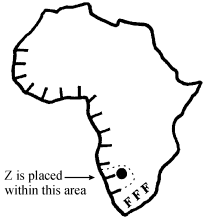Gondwanaland - evidence for the theory
This task is about shifting continents and plate tectonics.

The diagram represents landmasses as they now appear. These landmasses originally made up the super-continent called Gondwanaland.
Scientists have used many types of evidence to support the theory of continental drift (or plate tectonics).
| a) |
Use the information from the diagram above and your own knowledge to describe fully the evidence that would indicate that these landmasses were once joined, i.e., part of the super-continent of Gondwanaland.
|
|
| 1. |
|
|
| 2. |
|
|
| 3. |
|
|
| 4. |
|
|
| b) |
On the diagram of South America there is a "Z".
Put another Z on Africa at the place where these landmasses of Africa and South America were most likely joined.
|
|


